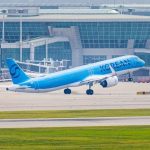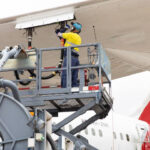Improvements in commercial aircraft efficiency have stagnated largely due to a sharp decline in the certification of new, more efficient aircraft types, finds a new study by the International Council on Clean Transportation (ICCT). New-type certifications have fallen from a peak of six per year in the late 1990s to less than one per year after 2020, when the international CO2 standard adopted by ICAO took effect. Beyond Boeing’s 777X, manufacturers have not committed to developing additional new aircraft types before 2035, says ICCT, which is calling on ICAO to strengthen the standard or risk aircraft efficiency improvements falling short of their anticipated contribution to meeting the industry’s net zero by 2050 target. The study comes as ICAO’s CAEP technical committee gathers for an important two-week meeting (CAEP/13) starting on February 17 that will consider the standard.
“This research demonstrates that ICAO’s 2028 CO2 standard lags state-of-the-art technology by about a decade,” said Nikita Pavlenko, ICCT’s Aviation Program Director, commenting on the working paper, ‘Fuel burn of new commercial jet aircraft: 1960 to 2024’.
“With improvements in new aircraft expected to contribute about one-sixth of all emission reductions under aviation’s net zero target, stronger standards are crucial.”
The first-ever fuel efficiency requirements for new aircraft were finalised by ICAO in 2016, took effect for new aircraft types in 2020 and will apply to all newly delivered aircraft, including models certified before 2020, starting in 2028.
As of 2024, the average new aircraft exceeded ICAO’s 2028 fuel burn standard by 8%, found ICCT. “However,” it adds, “the number of active commercial jet manufacturers has decreased and the variety of new aircraft types has sharply declined since 2020, limiting potential fuel burn improvements.”
ICCT says a CO2 standard 15% more stringent than the current standard is therefore needed to promote new types and calls for policies that focus on applying the CO2 standard to in-service aircraft that could encourage the adoption of new types. Carbon pricing could also be used to create additional demand for more fuel-efficient aircraft by raising the operating costs of older aircraft, it recommends.
ICCT also says newer data is needed to understand how much aircraft have improved since the standard was finalised.
The study found that some of the newest and most popular aircraft, including the Boeing 787-9 and 787-8, and the Airbus A320neo and A330neo already exceed the 2028 CO2 emission standard by 9%-11%.
“As the average new aircraft achieved an 8% margin with the standard in 2024, the CAEP/13 meeting will need to propose stricter standards that promote new-type aircraft, if the standards are to further improve the fuel burn of new deliveries,” it says.
It also highlights the importance of addressing gaps in the current standards, particularly for freighters, which lag passenger aircraft in terms of fuel burn reduction due to the limited introduction of new-type aircraft.
“The aviation industry’s commitment to net-zero emissions by 2050 requires continuous improvements in aircraft efficiency,” said Mehak Hameed, co-author of the study. “Our findings suggest that without stronger standards, the industry risks falling short of its climate goals.”
The Committee on Aviation Environmental Protection (CAEP), which works on a three-year cycle, assists the governing ICAO Council in formulating new policies and adopting new Standards and Recommended Practices (SARPs). The Council reviews and adopts CAEP recommendations, including amendments to the SARPs, and in turn reports to the ICAO Assembly where the main policies on environmental protection are determined. CAEP is currently composed of 32 Member States from around the world and 22 Observers. More than 1,200 experts are involved in CAEP activities and working groups, covering, for example, aircraft noise, airports and operations, CORSIA and emissions technical issues (the latter including the aircraft CO2 standard).
Photo (Boeing): Once certification is obtained, Boeing expects to deliver the first GE9X-powered 777X to customers in 2026















More News & Features
ICAO and IRENA launch Finvest platform to connect sustainable aviation projects with financiers
US rebukes ICAO for wasting resources on climate financing initiatives and warns against global levies
Countries gather for triennial ICAO Assembly, with a focus on CORSIA and SAF scale-up
COMMENTARY: China poised to evolve from rule-taker to rule-shaper at ICAO Assembly
Aviation needs better measurement to deliver meaningful decarbonisation
More targeted and faster measures needed to overcome barriers and unlock SAF’s full potential, finds PA study